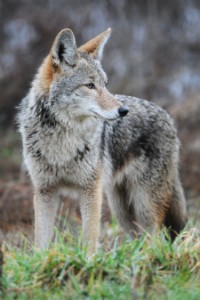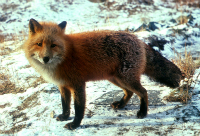Coyotes— They’re turning up everywhere!
By eNature
Coyote © Rebecca Richardson
People curse them, trap them, shoot them, but Coyotes continue to thrive.
In fact, their range has expanded greatly in the last fifty years. Whereas people once encountered Coyotes only in Canada and the American West, now these carnivores can be found across the East Coast of the United States as well, from Maine down to South Carolina. They’ve even been spotted in the heart of New York City and Washington DC.
But who are these new arrivals? And is their presence reason for concern?
Experts believe that the spread of Coyotes across the continent has been southward, from Canada, rather than eastward, from the West, with the largest numbers moving into new territories within the last several decades. Three factors have drawn Coyotes to these regions: an absence of natural predators, abundant habitat and prey, and wildlife regulations generally favorable to the animal’s survival.
It also helps that Coyotes are extremely adaptable. They prefer to live in open plains and prairies, but since such land is scarce in the East, they’ve settled into brushy areas instead, as well as fields, marshes, and at the edges of deciduous woodlands. The home territory of a single Coyote can measure up to five miles in diameter, and though Coyotes sometimes travel with their mates or with an extended family group, most often they’re seen alone.
Red Fox © USFWS
At first glance, a Coyote looks a lot like a Red Fox. Their size and coloration are about the same. The most obvious difference between these two animals lies in their tails. The tip of a Coyote’s tail is dark, while a Red Fox has a white-tipped tail. Also, a Coyote runs with its tail down, and a fox runs with its tail pointing straight out behind it. Another distinction is in their calls: both yip, but the Coyote quite often emits a series of barks and howls prior to its yipping calls.
As noted, Coyotes eat meat. Rabbits, hares, and White-tailed Deer carrion make up the bulk of an Eastern Coyote’s diet, but there are many other items on its menu, including the occasional family pet and one or a few watermelons from a garden patch. Coyotes are not shy around houses, and their curiosity and predatory instincts occasionally lead to trouble with humans.
For the record, Coyotes very rarely bite people, and when they do it’s usually because they’ve been induced into feeding from the hand. Yes, they raid garbage cans and gardens and have been known to kill cats and small dogs, but overall they’re not a negative addition to the landscape. The best strategy for dealing with them is to fence off sensitive areas and keep pets inside at night, when Coyotes are most active.
Have you encountered a coyote in a place where you didn’t expect to see one?
Share your stories – we’d love to hear them!


